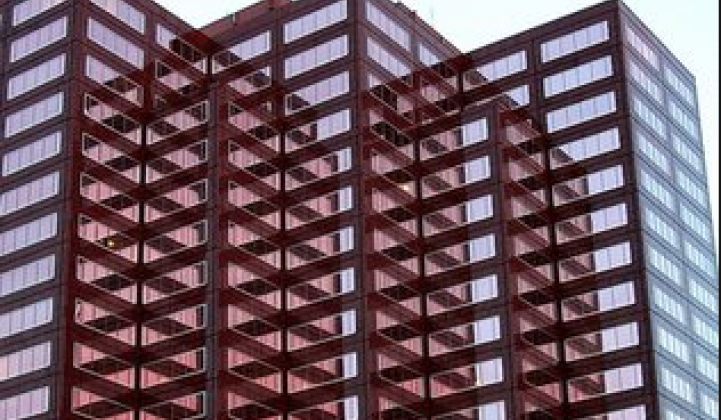Brian Swett knows real estate.
As LEED project manager for the large real estate investment trust Boston Properties until last year, Swett helped property owners and managers understand the value of green buildings.
And that background is helping him in his latest task as the chief of environment and strategy for the city of Boston: the rollout of a newly passed energy disclosure ordinance for buildings over the next five years.
"We've definitely seen some pushback. But at the end of the day, a lot of the concerns that were raised were based on lack of information," said Swett in an interview.
Boston's disclosure ordinance has been in the works since 2010, when Mayor Tom Menino brought together a stakeholder group and asked them to figure out how to get it done. The law, which will require non-residential buildings over 35,000 square feet and multi-family residential buildings with more than 35 units to report annual energy use, was passed by Boston's city council in May.
Some in the real estate community weren't happy about the ordinance. In April, the Greater Boston Real Estate Board funded a Harvard study concluding energy disclosure laws are not effective. Some opponents argued the law was "intrusive" and would disadvantage Boston because its building stock is much older than most cities.
"The reality is that we know that's not true," said Swett. "Take a look at what happened in New York when they finally started tracking energy use in buildings."
When New York City released the first set of data on building energy use, it found that some of the oldest buildings were outperforming some new LEED buildings. That was because many early buildings were designed with very tight envelopes before sophisticated HVAC equipment came along.
That was just one of the lessons learned as Boston ramped up its negotiations with the real estate community and other stakeholders. Figuring out the appropriate threshold for buildings was another.
"There was definitely a benefit in not being first. It was good for us to learn from the first movers. It helped us find a middle ground," said Swett.
San Francisco applied its disclosure law to buildings over 10,000 square feet; Chicago and New York City applied their requirements to commercial and municipal buildings over 50,000 square feet. Boston opted for a compromise of 35,000 square feet -- raising the threshold from the 25,000 square feet threshold originally proposed.
"We ended up compromising, but at the end of the day, it still covered a lot of our buildings," said Swett.
Although the city raised the floor by 10,000 square feet, that only took about 9 percent of the city's square footage off the table. So the current law still covers 1,600 buildings and 40 percent of square footage in the city.
There are currently two states and eight cities -- Austin, Boston, Chicago, New York, Philadelphia, San Francisco, Seattle and Washington, D.C. -- with energy disclosure requirements. Like Boston, each city and state is trying to find a balance without compromising program performance.
"If these laws are not implemented properly, they could just be a feel-good exercise," said Paul Hamilton, vice president of government affairs at Schneider Electric.
Hamilton was part of a panel discussion on energy disclosure at the EE Global Forum in Washington this May.
So far, it's still too early to tell the difference in effectiveness between cities with varying thresholds for building size and type. And that limited experience has a lot of property owners worried.
"These programs and other labeling programs vary in quality and usefulness. There's a lack of history, and they are not consistent," said Hamilton. "As a result, labeling and disclosure remains a controversial project, with property owners worried they will get stigmatized."
Energy disclosure is not intended to work as an isolated policy, however. Most program administrators are connecting state and local incentive programs with disclosure requirements, creating opportunities for retrofits, not punishments, said David Goldstein, energy program co-director for the Natural Resources Defense Council.
"You don't tell the owner their property is defective -- you give them a way to do something about it," said Goldstein, speaking on the panel. "If you're asking them to do something that costs money, it won't make sense without a web of interventions."
That's exactly what Brian Swett has been trying to do in Boston. Instead of penalizing building owners with a fine, underperforming building owners will be required to get an additional audit. The program also helps owners connect to the numerous state incentives for efficiency retrofits in Massachusetts.
"The reality is that it's way too tough to create hard penalties. I'm more interested in setting up a process that ensures that cost-effective energy measures are going to be made," said Swett. "This is about creating a full suite of behavior change and empowering folks."
Although there's still quite a bit of resistance to building energy disclosure, the market is moving in that direction anyway.
In Boston, there are 900 buildings covered by the new ordinance that were part of the Energy Star portfolio manager, a voluntary program for tracking energy consumption and carbon emissions. And because some of the largest real estate companies in Boston -- Beacon Capital, Boston Properties and Samuels & Associates -- were already involved in Energy Star and LEED, getting them to the table wasn't difficult.
"We were arguably close to halfway there already," said Swett.
As more cities and states consider energy disclosure laws, resistance will likely continue. But that's exactly what happened with other laws -- seat belt requirements, calorie labeling and toxic chemical disclosure -- that eventually became the norm, said Goldstein.
"Markets cannot function without standards. We've seen this resistance before. If you don’t know what it is you’re selling or buying, markets won’t give you an optimal answer," said Goldstein



